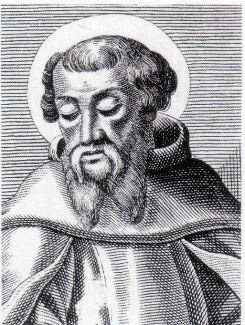Text from The Saint Andrew Daily Missal,
unless otherwise stated.
Saint Leo II.
Pope and Confessor.
Feast Day 3 July.
Semi-Double.
White Vestments.
English: Portrait of Pope Saint Leo II.
Español: Imagen del papa leon II.
Date: Unknown.
Source: Basilica di San Paolo-fuori-le-Mura, Roma.
Author: Unknown.
(Wikimedia Commons)
Saint Leo II, a Sicilian by birth, participated in the full Priesthood of Christ (Introit, Epistle, Gradual, Alleluia) on becoming Pope. Guided by the Holy Ghost, Pope Leo II gave their full value to the spiritual riches of the Church committed to his care by Jesus (Gospel, Communion).
He approved the Acts of the Sixth Council, which condemned those who taught that Christ has only one will. Well versed in Sacred Singing, he perfected the melodies of the Psalms and of the Hymns of the Church.
He was truly the father of the poor and, by his example and Preaching, led everyone to virtue. He died in 683 A.D. and was buried in the Basilica of Saint Peter.
Let us imitate the example of this Saint (Collect), who was one of the successors of Saint Peter on the Pontifical Throne.
Mass: Sacerdotes tui.
The following Text is from Wikipedia - the free encyclopaedia,
unless otherwise stated.
Pope Saint Leo II (611 A.D. – 683 A.D.) was Pope from 682 A.D. to his death in 683 A.D.
He was a Sicilian by birth (the son of a man named Paulus), and succeeded Pope Agatho. Though elected Pope a few days after the death of Saint Agatho (10 January 681 A.D.), he was not Consecrated until after the lapse of a year and seven months (17 August 682). Pope Saint Leo was known as an eloquent Preacher, who was interested in music, and noted for his Charity to the poor.
Elected shortly after the death of Pope Agatho, Pope Leo II was not Consecrated for over a year and a half. The reason may have been due to negotiations regarding Imperial control of Papal Elections.
These negotiations were undertaken by Pope Leo's predecessor, Agatho, between the Holy See and Emperor Constantine IV. They concerned the relations of the Byzantine Court to Papal Elections. Emperor Constantine IV had already promised Agatho to abolish or reduce the tax, that the Popes had been paying to the Imperial Treasury, at the time of their Consecration, an Imperial policy that had been in force for about a Century.
Pope Leo's short-lived Pontificate did not allow him to accomplish much, but there was one achievement of major importance: he confirmed the Acts of the Sixth Ecumenical Council (680 A.D. - 681 A.D.). This Council had been held in Constantinople, against the Monothelite controversy, and had been presided over by the Legates of Pope Agatho. After Pope Leo had notified the Emperor that the Decrees of the Council had been confirmed, he made them known to the nations of the West. In Letters written to the King, the Bishops, and the nobles of Spain, he explained what the Council had effected, and he called upon the Bishops to subscribe to its Decrees.
During this Council, Pope Honorius I (625 A.D. - 628 A.D.) was anathematised for his views in the Monothelite controversy as tolerant of Heresy. Pope Leo took great pains to make it clear that, in condemning Pope Honorius, he did so not because Honorius taught Heresy, but because he was not active enough in opposing it. In accordance with the Papal Mandate, a Synod was held at Toledo in 684 A.D., in which the Council of Constantinople was accepted.
Regarding the decision of the Council, Pope Leo wrote once again in approbation of the decision of the Council and in condemnation of Honorius, whom he regarded as one who "profana proditione immaculatem fidem subvertare conatus est" (roughly, "one who by betrayal has tried to overthrow the Immaculate Faith").
In their bearing upon the question of Papal Infallibility, these words have caused considerable attention and controversy, and prominence is given to the circumstance that, in the Greek Text of the Letter to the Emperor, where the phrase occurs, the milder expression "subverti permisit" ("allowed to be overthrown . . .") is used for "subvertare conatus est".
At this time, Pope Leo II put an end to the attempts of the Ravenna Archbishops to get away from the control of the Bishop of Rome. The Pope sweetened the deal for the Ravenna Bishops by abolishing the tax it had been customary for them to pay, when they received the Pallium.
Also, in apparent response to Lombard raids, Pope Leo transferred the Relics, of a number of Martyrs, from the Catacombs to Churches inside the walls of the City. He also Dedicated two Churches, Saint Paul's and Saints Sebastian and George.
Pope Leo II was originally buried in his own Monument; however, some years after his death, his remains were put into a tomb that contained all four Pope Leos (Popes Leo I, II, III, IV).


































